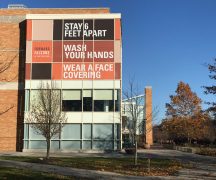By DAVID DUPONT
BG Independent News
COVID-19 cases at BGSU continue to tick upward as the clock on the semester continues to tick downward.
Provost Joe Whitehead started his remarks at Wednesday’s Town Hall meeting on campus, with a number: 1,383,400. That was, he explained 13 seconds later the number of seconds before commencement.
“The clock is ticking, and the semester is winding down,” said Chief Health and Wellness Officer Ben Batey. With students heading home that should deter “any potential massive spike.”
The COVID-19 dashboard shows 20 new cases of COVID-19 reported. That’s an uptick from 11 the week before, which itself was slightly more than the week before.
That “mirrors,” he said, what is happening in the county and elsewhere in the state and nation, though in Erie County, where BGSU’s Firelands campus is located, cases have reached a plateau.
Among public health officials “this was always the expectation that we’d see a bit of a bump here in mid-April based on what we see with the BA.2 variant of Omicron,” he said.
Omicron is interesting because it is spinning off its own variants, most recently the XE variant. While these are highly transmissible, Batey said, they are not very virulent. So hospitalizations have not gone up.
Public health officials are continuing to monitor the situation, including analyzing the presence of the virus in wastewater and this confirmed a greater presence of the virus.
Batey said he continues to urged students to get tested if they have any symptoms, and to take test kits home with them when they leave campus.
“We have handed out more test kits than any other place in the county, maybe Northwest Ohio.”
Batey said no decision has been made about maintaining the vaccination requirement on campus. The situation is very different than when that was imposed for this semester. “We had a large population with no immunity whatsoever and had vaccines that were readily available.” He said an estimated 98 percent of the population in the US now has some immunity to the disease.
The timetables for when people should get boosters is complicated, based on age, vaccination timing, exposure to the virus, and vulnerability.
So he’s still urging people to get vaccinated when necessary. He did say some over 50 may want to wait a bit before getting the second booster to extend their immunity. There will be vaccination clinics both for COVID and influenza next fall.
Those who are particularly vulnerable should consult with their doctors to determine what’s the best kind of mask to wear. Though mask mandates have been largely lifted in some situations they are still appropriate, Batey said. If he’s in a situation where the person he’s dealing with is wearing a mask, he will, too. He still keeps one in his pocket.
“We’re not necessarily looking at having a mandate for the fall,” Batey said. But he’s not making that decision now. He doesn’t want to be locked in to an action knowing that the situation could change dramatically within a month.
Referring to recent conversation with Amy Acton, former director of the Ohio Department of Health, he said they agreed “mandates and requirements should be reserved for the most severe circumstances, so we do reserve that right.”
[RELATED: How Dr. Amy Acton became the ‘Ted Lasso’ of pandemic politics]
Overall, Batey is optimistic. “We’re starting to feel somewhat OK. Maybe not normal, but as normal as we can be in comparison to where we were before we knew what COVID-19 was.”




